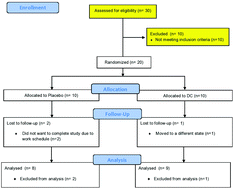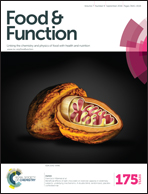Beneficial effects of dark chocolate on exercise capacity in sedentary subjects: underlying mechanisms. A double blind, randomized, placebo controlled trial†
Abstract
In heart failure patients the consumption of (−)-epicatechin ((−)-Epi)-rich cocoa can restore skeletal muscle (SkM) mitochondrial structure and decrease biomarkers of oxidative stress. However, nothing is known about its effects on exercise capacity and underlying mechanisms in normal, sedentary subjects. Twenty normal, sedentary subjects (∼50 years old) were randomized to placebo or dark chocolate (DC) groups and consumed 20 g of the products for 3 months. Subjects underwent before and after treatment, bicycle ergometry to assess VO2 max and work, SkM biopsy to assess changes in mitochondrial density, function and oxidative stress and blood sampling to assess metabolic endpoints. Seventeen subjects completed the trial. In the DC group (n = 9), VO2 max increased (17% increase, p = 0.056) as well as maximum work (watts) achieved (p = 0.026) with no changes with placebo (n = 8). The DC group evidenced increases in HDL levels (p = 0.005) and decreased triglycerides (p = 0.07). With DC, SkM evidenced significant increases in protein levels for LKB1, AMPK and PGC1α and in their active forms (phosphorylated AMPK and LKB1) as well as in citrate synthase activity while no changes were observed in mitochondrial density. With DC, significant increases in SkM reduced glutathione levels and decreases in protein carbonylation were observed. Improvements in maximum work achieved and VO2 max may be due to DC activation of upstream control systems and enhancement of SkM mitochondria efficiency. Larger clinical studies are warranted to confirm these observations.


 Please wait while we load your content...
Please wait while we load your content...